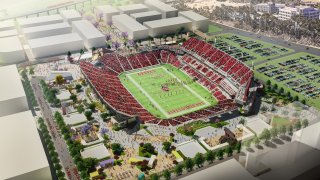
NBC 7's Derek Togerson looks at the impact a new Mission Valley stadium could have on SDSU athletics in this commentary
Shovels ceremoniously diving into dirt is a symbol of hope for San Diego State's athletics department. While several programs like soccer and lacrosse will call Aztec Stadium home, make no mistake: This facility is being built for football.
The driving financial force of almost every Division 1 program is football, which typically costs -- and raises -- more money than any other sport, so the new stadium being the most pressing aspect of SDSU's campus expansion makes sense. What the Aztecs are hoping for is a lot of R&R: revenue & recruiting.
Playing at cavernous, crusty, cement-colored SDCCU Stadium certainly didn't do anything to help in those categories. The Aztecs are banking on a modern 35,000-seat venue with luxury boxes and video boards that were built after 1978 to energize San Diego football fans into buying a whole lot more (and more expensive) tickets. They're also hoping that the shiny new digs will make more (and more talented) recruits choose to play on Montezuma Mesa.
SDSU understands it's not going to build a stadium and suddenly turn into Auburn or Michigan, but its hopes for a more dominant program are legitimate. Let's look at a conference rival who may have provided a blueprint for what's about to come for the Aztecs.
Colorado State University recently went through a stadium construction, hoping for the same thing the Aztecs want. They needed more revenue for the athletics department and believed that a new destination for football fans to watch a consistent winner would do the trick. It opened in 2017.
At first, revenues spiked. CSU saw a 40% increase in season tickets and set a program record for average attendance, at 32,062 per game. The Rams football program was even able to generate more money than the athletics department's projections and overcame an operative deficit for the rest of the school's programs.
Local
In 2018, attendance stayed strong at more than 31,500 per game, so folks wanted to see football in a new venue. However, it's the other half of the R&R that at least temporarily short-circuited the cash flow.
Here's a look at the CSU recruiting class rankings over the last few years, according to national analysts 247 Sports:
2013 - 84th
2014 - 86th
2015 - 119th (construction began)
2016 - 76th
2017 - 73rd (stadium opened)
2018 - 86th
2019 - 84th
The Rams had the exact same national ranking two years before stadium construction began as they did two years after it opened, so it appears that part of the equation hasn't improved.
Other than the quality of facilities, there are a ton of factors when trying to land a recruit, among them who the head coach is, location and who the other programs are in pursuit of that recruit. But usually the most important factor is winning. Here's how the Rams have done on the field in each of those seasons:
2013: 8-6 (won the New Mexico Bowl)
2014: 10-3 (lost the Las Vegas Bowl)
2015: 7-6 (lost the Arizona Bowl)
2016: 7-6 (Famous Idaho Potatoes Bowl)
2017: 7-6 (lost the New Mexico Bowl)
2018: 3-9
2019: 4-8
The Rams haven't won a Mountain West Conference championship since 2002. Really good football players want to have a chance to win every week, and fans want to watch a winner. As soon as the Rams stopped being competitive,, people stopped coming. In 2019 attendance dipped to 22,501 a game, and the biggest single crowd was 29,767 ... when San Diego State came to town.
That's the area SDSU has an edge on CSU. The Aztecs have been to 10 straight bowl games and won half of them. They've won three of the last eight MWC titles and been in contention every year for nearly a decade.
If we can assume the novelty of the new stadium will initially increase revenue (a safe bet, I think), then the trick will be putting a consistent winner on the field. That's something the Aztecs have proven they can do.
Another factor here is scheduling. One of the biggest complaints the Aztecs have had is that Power 5 schools don't want to play in San Diego. They've just started getting Pac-12 schools like Stanford, ASU and UCLA to come to town again, but they'd like to start dipping into some even bigger pools.
When CSU opened its new stadium, it got Arkansas to come in for a game. Sure, it's a terrible SEC team, but it's still an SEC team. Had the COVID-19 pandemic not delayed the season, the Rams would have hosted Colorado from the Pac-12, the first time the Buffaloes would have made the trip to Fort Collins since 1996.
It's not out of the question to think a new stadium could get teams like Georgia or Florida State to start making trips to San Diego. Those games get on national TV. National TV means more money and exposure.
Or, put another way, it's another avenue to increased R&R.
Is this stadium a gamble? Yes. Is it a gamble worth taking? Absolutely.



